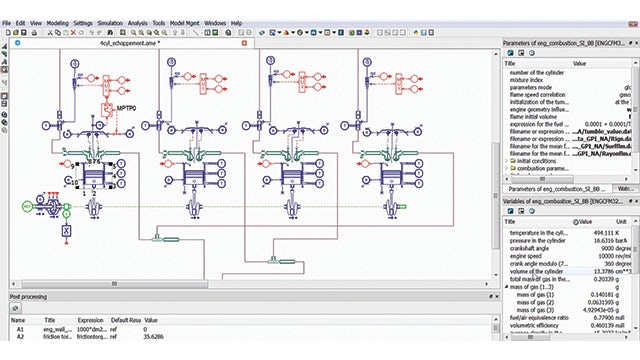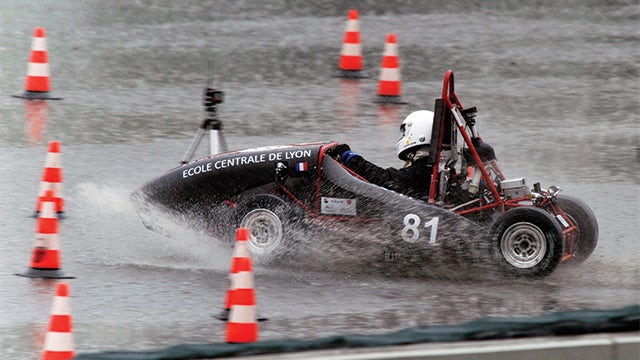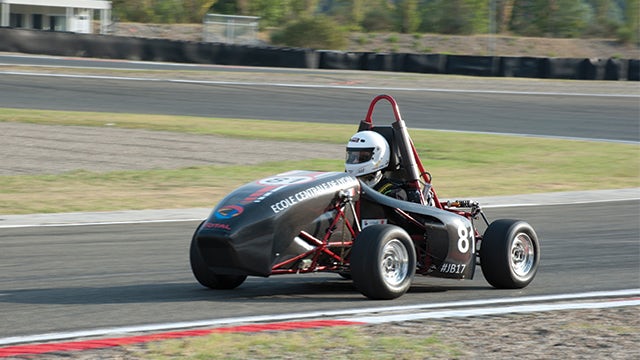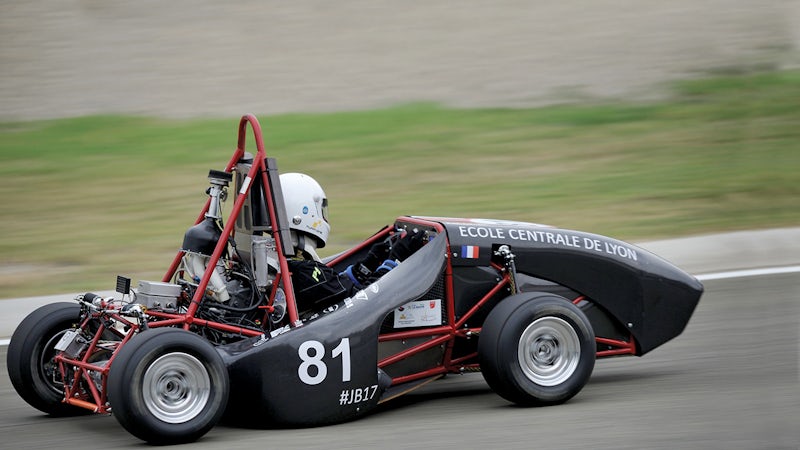Engineering school uses Simcenter Amesim to gain five horsepower in racecar engine
Siemens Digital Industries Software solution enables École Centrale de Lyon students to improve engine intake and exhaust system performance
École Centrale de Lyon
École Centrale de Lyon is a French engineering school based in Lyon. It allows students to work on challenging projects in which they can put into practice everything they have learned in their program. The Ecurie Piston Sport Auto (EPSA) is a student organization whose objective is to promote automobile sports and engineering in the school.
http://www.epsa-team.com- Headquarters:
- Lyon , France
- Products:
- Simcenter Products, Simcenter Amesim
- Industry Sector:
- Automotive & transportation
We used Simcenter Amesim to validate submodels, thus allowing us to perform a first and valuable simulation very quickly
École Centrale de Lyon
Coping with educational challenges
Engineers are now confronted with ever-increasing industry challenges, so engineering students must acquire top-notch design skills in order to meet job market demand.
In order to better prepare students, universities organize engineering contests based on designing and manufacturing racecars. This type of contest complements the students’ theoretical education with a challenging and interesting experience. Students are also asked to consider the economic aspects of automotive engineering.
For the Formula Student competition, the participants need to develop a racecar prototype that will be tested for series production. In this project, the target customer is an amateur weekend racer for whom the vehicle must offer comfortable driving dynamics for acceleration, braking and handling. In addition, it should be reliable and offered at a reasonable price. Finally, the vehicle’s rating will increase according to other factors, such as ergonomics, aesthetics and the use of available standard-purchase components.
In an educational context, testing and prototyping must be reduced as much as possible. Typically, universities and engineering schools do not have big budgets to support this kind of contest, so reducing costs is a priority. In addition, to obtain the best score, students must study the dynamics and behavior of their cars, and fully understand the systems and subsystems in order to improve them.
This type of advanced analysis must be taken into account early in the design cycle to maximize development efficiency while reducing costs. This type of detailed procedure is exactly what mechatronic system simulation is meant to address.

Optimizing highly competitive automobile systems
École Centrale de Lyon is a French engineering school based in Lyon. The school allows students to work on challenging projects in which they can put into practice what they have learned in their curriculum. École Centrale de Lyon hosts the Ecurie Piston Sport Auto (EPSA), a student organization whose objective is to promote automotive sports and engineering in the school. Each year students conceive and build a racing vehicle to participate in the Formula Student international competition. This international automobile race is divided into several events that take place in countries such as England, Italy, Germany, the United States and Australia.
This year, the EPSA team worked on a fascinating new automotive project called Atomix, a single-driver car that weighs around 200 kilograms (kg). Since the vehicle will participate at Formula Student, three aspects must be carefully taken into account: first, the vehicle dynamics in the circuit, including the acceleration, hairpin turns and dynamics under dry and wet conditions; second, the production efficiency, meaning the capacity to mass produce a vehicle at low cost; and finally, the eco-friendliness of the automobile, which is judged on fuel consumption.
In order to cope with these three challenges in a seamless and cost-saving way, the EPSA team decided to move away from analysis based on back-of-the-envelope calculations, which was too difficult to perform and had a high margin of error, to a model-based systems engineering (MBSE) approach. This alternative strategy completely changed the way students at École Centrale de Lyon worked.

Boosting engine intake and exhaust systems performance
In the first year of participation at the Formula Student contest, students at the EPSA had to face a critical issue concerning the sizing of the exhaust and emission systems. In the interest of gaining maximal engine performance, it is important to achieve a perfect acoustic flow balance between these two systems.
The main concern was being able to create an accurate mechanical model of the engine. However, the previous calculation methods used by the EPSA team did not allow them to precisely understand the behavior of all engine subsystems.
Simcenter Amesim™ software from product lifecycle management (PLM) specialist Siemens Digital Industries Software proved to be the best solution to enhance the students’ engineering capabilities and support their ideas.The multi-domain system simulation solution is being used by École Centrale de Lyon for three main purposes.
First, Simcenter Amesim is being used to study the thermodynamics of an engine. The gasses coming out of the engine can reach 1,200 degrees Celsius. In contrast, the temperatures of gasses coming out of the exhaust system can be reduced by as much as 400 degrees. These huge temperature gradients are now analyzed using Simcenter Amesim.
Second, fluid dynamics are also being studied with Simcenter Amesim. All kinds of losses inside the engine – including fuel and power – can now be identified and avoided in a simple and accurate way.
Finally, Simcenter Amesim is used by the EPSA team to study exhaust acoustics. The exhaust manifold used for the Atomix racecar is connected to four cylinders, which produce overpressure waves that reflect over the exhaust pipe walls. The length of the pipes must then be optimized to allow the overpressure waves to appear in each pipe at the correct time, according to valve timing.
In order to perform this kind of analysis, students at École Centrale de Lyon are using several Simcenter Amesim functionalities, such as the frequency and time analysis tools. In addition, they are also using Simcenter Amesim libraries, including IFP-Drive, IFP-Engine, CFD1D and the mechanical library.

Enabling analysis of complex physical phenomena
Simcenter Amesim enables the EPSA to perform simulations on highly complex physical phenomena. The solutions that were previously used at the school required the ability to create each physical model from scratch, leading to longer development periods and a greater possibility of errors.
“Many other simulation tools require a long adaptation and training period in order to obtain sustainable results,” says Thomas Courtade, an engineering student at École Centrale de Lyon. “We used Simcenter Amesim to validate submodels, thus allowing us to perform a first and valuable simulation very quickly.”
It was possible to begin with very general models to study global results, and then explore subsystems and specific components in order to obtain more accurate and focused results.
“The EPSA team really appreciates the user-friendly aspect of Simcenter Amesim,” says Courtade. “The graphical interface of the software allows students to easily explore and learn all the capabilities of Simcenter Amesim, enabling them to fully complete their projects on time.”
“The results obtained with Simcenter Amesim allow us to better understand the physical phenomena that we are currently studying in our school curriculum. In this manner, the pedagogical role of Simcenter Amesim is something that must be highlighted.”
“We have found a place for Simcenter Amesim in our engineering workflow. When launching a simulation of a predefined model, we quickly obtain accurate results, completely fulfilling our expectations.”
Using Simcenter Amesim has changed the way the EPSA team works.
“All models we create with Simcenter Amesim are like goldmines for the next generations of students,” says MarcAntoine Salmon, engineering student at École Centrale de Lyon. “Since the project must be done in a year, the team does not have too much time to perform testing on real-life systems. This lack of time is being alleviated thanks to MBSE. Moreover, Simcenter Amesim has helped us increase and optimize the quality of prototypes at every design stage.”
Nonetheless, the positive effects of Simcenter Amesim can also be seen in the racecar. “We have managed to gain an extra five horsepower in our engine by optimizing the intake and exhaust systems with Simcenter Amesim,” says Courtade.
Finally, it is important to note that the EPSA is interested in developing hybrid-electric racing vehicles that will allow students to explore the new technologies that are leading today’s industrial challenges. Siemens Digital Industries Software expects to facilitate this exploration by providing École Centrale de Lyon students the tools to meet these new challenges.

The results obtained with Simcenter Amesim allow us to better understand the physical phenomena that we are currently studying in our school curriculum
École Centrale de Lyon
